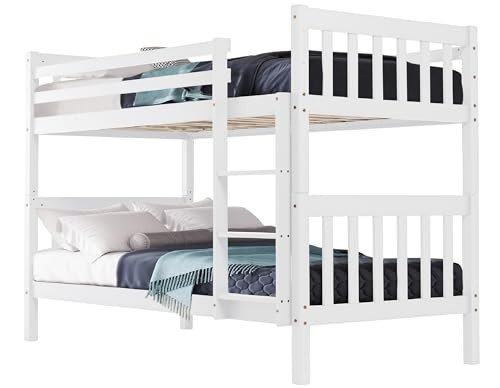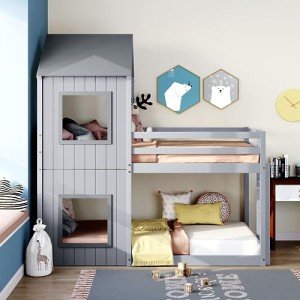bunk_bed8317
About bunk_bed8317
The Best Bunk Beds House Tricks To Transform Your Life

The Comprehensive Guide to Bunk Beds House: Maximizing Space and Functionality
Bunk beds are becoming significantly popular in modern families, particularly for those residing in restricted space. Whether in a child’s bedroom, a visitor space, or perhaps a vacation home, bunk beds provide an innovative option for maximizing space while likewise accommodating several sleepers. This article digs into the different aspects of bunk beds, their style options, advantages, and considerations for upkeep to assist anyone thinking about a bunk bed purchase make an informed choice.
Understanding Bunk Beds
Bunk beds are a kind of bed that includes one bed stacked on top of another, generally secured by a ladder or built-in stairs. They are frequently made from wood or metal, with styles varying from standard to contemporary. Bunk beds are most commonly utilized in kids’s rooms, guest accommodations, and summer camps, but they can also be a great addition to studio apartments or homes.
Kinds Of Bunk Beds
Comprehending the ranges of bunk beds can help one select the right style for one’s requirements. Here are the common types:
| Type | Description | Pros | Cons |
|---|---|---|---|
| Standard Bunk | 2 beds stacked on top of each other | Space-saving, traditional style | Minimal sleeping capacity for adults |
| Loft Bed | A bed raised with open space beneath for an office or play area | Provides additional usable space | Not perfect for more youthful kids |
| Futon Bunk | A bed on top, typically with a futon on the bottom | Versatile for sleeping and seating | Less stability compared to traditional bunks |
| L-Shaped Bunk | 2 beds organized in an L-shape, often with storage choices | Distinct design, can suit corners | Takes up more space than basic Best Bunk Bed beds |
| Triple Bunk | 3 beds arranged vertically or in a distinct setup | Optimizes sleeping space | Greater risk of accidents, more complex to make |
Advantages of Bunk Beds
Bunk beds provide many benefits, making them a practical furniture option for numerous living spaces. The advantages include:
- Space Efficiency: Perfect for small spaces, they enable more floor space, making it much easier to move around.
- Dual Functionality: Especially when it comes to loft-style beds, the space underneath can be used for a research study location, a play zone, or additional storage.
- Social Interaction: Bunk beds create a sense of camaraderie amongst siblings or roomies, promoting sharing and bonding.
- Cost-Effective Sleeping Solution: They supply an affordable method to accommodate multiple visitors without the requirement to purchase extra separate beds.
- Style Variety: With options varying from smooth modern designs to timeless wooden structures, there is a bunk bed design to fit any decoration.
Essential Considerations for Bunk Beds
While bunk beds offer several advantages, there are certain factors to consider to remember to make sure safety and longevity:
- Weight Capacity: Always examine the weight limit of the bunk bed to avoid accidents. Most basic bunk beds have weight capacities between 200-400 pounds.
- Product Quality: Opt for durable materials such as strong wood or high-grade metal to make sure stability and durability.
- Security Features: Look for models with guard rails on the top bunk and large ladders. Guarantee that the bed feet are stable and safe.
- Age Appropriateness: Young kids need to not oversleep the leading bunk, as the risk of falling is substantially increased.
- Assembly: Some bunk beds can be complex to assemble. Make sure that good instructions are offered, or think about expert assembly.
Upkeep of Bunk Beds
Proper maintenance of bunk beds is vital for guaranteeing their convenience and security. Here are some tips for maintenance:
- Regular Inspections: Periodically examine the stability of the bed, ensuring all screws and parts are tight and safe and secure.
- Cleaning: Dust the furniture frequently and clean up any spills instantly to maintain the stability and look of the beds.
- Bed mattress Care: Rotate bed mattress occasionally to prevent wear and sagging. Consider hypoallergenic bed mattress protectors for added comfort and cleanliness.
- Readjust if Moved: If the bed is relocated, readjust all elements to ensure continued safety and stability.
Frequently Asked Questions about Bunk Beds
Q1: Are bunk beds safe for children?A1: Yes, as long as safety guidelines are abided by. Guarantee the top bunk has guardrails, and that children are old sufficient and accountable enough to securely use the top bunk. Q2: How much weight can a bunk

bed support?A2: Most bunk beds support between 200 to 400 pounds per bed
, but this can vary by style. Always describe the producer’s requirements. Q3: Can adults sleep in bunk beds?A3: Yes, many modern-day bunk beds are
created to accommodate adults, particularly those with reinforced frames. Q4: Do bunk beds require unique mattresses?A4: Not always. Standard bed mattress can be utilized as long as they fit the
dimensions provided by the producer. However,
consider using thinner bed mattress for the top bunk to guarantee security clearance. Q5: How can I maximize space in a room with bunk beds?A5: Use the location underneath for storage or desks, and think about integrating vertical storage
services to keep the space uncluttered. Bunk beds offer an exceptional solution for maximizing space in a home while providing an elegant and functional sleeping plan. Whether for a child’s space, a guest space, or a holiday house, they are a versatile alternative that can accommodate different requirements. By considering types, benefits, and appropriate maintenance, people can make informed choices, making sure security and durability in their bunk bed investment. With mindful selection, bunk beds can boost both convenience and visual appeal in any space.
No listing found.
